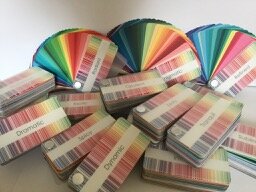Colour Analysis: What’s my Season?
Are you tired of staring at your closet with no idea what to wear? Do you ever wonder why certain colours make you look and feel amazing, while others just don't seem to work? Then read on, at Wearable Wardrobes, we believe that understanding your personal colour palette is key to unlocking a wardrobe full of clothes you love to wear.
In this post, we'll guide you through the process of determining your best season, and explain why it's important to consider the Absolute Colour System as well.
Get ready to feel confident and stylish in every outfit!
What is the Seasonal Colour Analysis System?
Let’s start by looking at the basis of the Seasonal Colour Analysis System. While colour analysis for clothes has been around a long time, it was popularised when Carole Jackson published Colour Me Beautiful and formalised the Seasonal Colour Analysis System.
Each season is based on two of Henry Munsell’s properties of colour - warmth and value.
Autumn is warm and dark. Spring is warm and light.
Winter is cool and dark. Summer is cool and light.
How to Determine Your Season
To determine your season you need to determine your personal colour properties: Value and Warmth.
Value
Your value is determined by the colour of your hair. If you have dark hair, your value will be dark. If you have light hair, your value will be light.
A value of 5 or less on the value chart is considered dark, while a value of 6 or higher is considered light. Easy right?
Warmth
Warmth is much harder to determine as it is your undertone not the overtone or hue that is important. That is another way of saying that the colour (red, yellow, blue, green etc) is not important, but rather whether the the pure colour has been warmed up (with a bit of yellow or red) or cooled down (with a bit of blue).
Think about the difference in colour between a ripe tomato and a ripe raspberry. The raspberry is a cooler, bluer red and the tomato a warmer more orangey red -or red with some yellow added to it.
Determining your season
Short of doing a professional colour analysis, the best approach is to first determine your value and then your warmth.
Determine your value looking at how dark your hair is. If you have no hair, then follow the same approach as for colours below.
Determining you warmth is trickier. There are lots of suggestions online like checking the colour of your veins, or looking at how easily you tan. None of these worked or me.
The best approach is to try on warm and a cool versions of colours and see what looks best on you. Trying on colours in the your best value or at least the same value will give you a better result.
For example, try on a raspberry and a tomato red (of similar value or darkness) and see which one looks best on you.
If you are warm and dark you are Autumn, warm and light you are Spring is warm and light.
If you are cool and dark you are Winter, cool and light you are Summer.
Seasons and the Absolute Colour System
The system I use is based on all 3 of Henry Munsell’s properties of colour: warmth, intensity and value. It has 18 palettes, which provides a better match to each individual’s colours.
Determining Your Season from Your Absolute Colour System Palette
A lot of people are familiar with the Seasonal Colour Analysis System so if you have had your colours done with the Absolute Colour System, it can be handy to know how they relate the Seasonal system.
Rich, Exotic, Opulent and Enigmatic are warm and dark, just like Autumn.
Zesty, Spicy, Exquisite, Intriguing are warm and light, like Spring.
Radiant sits in the middle of Autumn and Spring, with warm vibrant mid-value colours.
Dynamic, Elegant, Mysterious and Sophisticated are cool and dark, just like Winter.
Refined, Sublime, Tranquil and Serene are cool and light, just like Summer.
Dramatic sits in the middle with cool, vibrant mid-value colours.
How do the is Absolute Colour System Palettes differ?
The differences between the palettes is their intensity. The ones mentioned first for each season are the brightest, with those mentioned last are the softest. The softer colours have had more grey, white, black or or brown added to the them.
What’s my Absolute Colour System Palette?
Your Absolute Colour System Palette is harder to determine alone than your season, as I haven’t seen an objective guide to intensity and it is much harder to tell by looking at someone unless you have a standard colour palette to compare it to. I recommend a professional colour analysis to determine your palette.
What next?
Finding out your best overall value is a simple and easy way to start to wearing colours that suit you better. Wear cardigans and jackets in this value in winter, and uncovered, short-sleeved tops in summer.
I hope that this blog post has been helpful in guiding you towards discovering your best colours. If you have any thoughts on colour analysis or this article, please feel free to leave a comment below and share your experiences.


